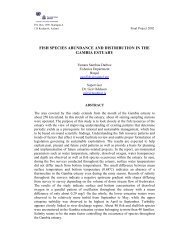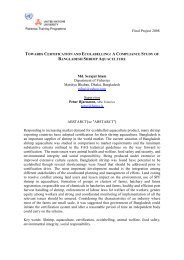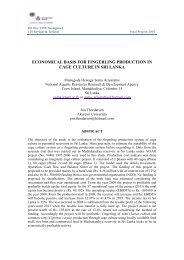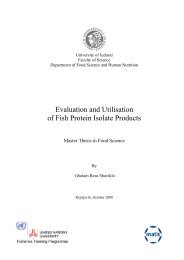Quality Indicators of Northern Shrimp (Pandalus borealis)
Quality Indicators of Northern Shrimp (Pandalus borealis)
Quality Indicators of Northern Shrimp (Pandalus borealis)
You also want an ePaper? Increase the reach of your titles
YUMPU automatically turns print PDFs into web optimized ePapers that Google loves.
QingzhuACKNOWLEDGEMENTS.............................................................................................. 40List <strong>of</strong> REFERENCES...................................................................................................... 41APPENDIX....................................................................................................................... 45LIST OF TABLESTable 1: Latent heat <strong>of</strong> fusion (∆H f ) <strong>of</strong> the different cooling agent, the minimum quantityneeded to cool the shrimp and keep it chilled (Mi total) and the quantity used for 15kg <strong>of</strong> shrimp (Mi used). ............................................................................................ 12Table 2: Experimental groups and sampling plan............................................................ 12Table 3: Score sheet for quality grading scheme <strong>of</strong> whole shrimp (IFL 2003). .............. 13Table 4: Correlation (r) <strong>of</strong> between parameters for quality assessment <strong>of</strong> shrimp.......... 31LIST OF FIGURESFigure 1: A typical texture pr<strong>of</strong>ile analysis (TPA) curve ( Malcolm 2002). ................... 11Figure 2: Texture analyzer (TA-XT2I Texture Analyzer) used to measure texture changein shrimp. .................................................................................................................. 15Figure 3: Electronic nose FreshSense used to measure quality change <strong>of</strong> shrimp. ......... 16Figure 4: The center temperature in each bin holding sample during storage. ICE/+: flackice at 1.5 o C; LIQ/+: liquid ice at 1.5 o C; S-ICE/-: salt-water + ice -1.5 o C; LIQ/-:liquid ice at -1.5 o C. ................................................................................................... 18Figure 5: Sensory scores <strong>of</strong> shrimp stored in different cooling conditions. ICE/+: flackice at 1.5 o C; LIQ/+: liquid ice at 1.5 o C; S-ICE/-: salt-water + ice -1.5 o C; LIQ/-:liquid ice at -1.5 o C. ................................................................................................... 19Figure 6: Appearance <strong>of</strong> shrimp stored in different cooling conditions on the day 6 th <strong>of</strong>storage. PIC (ICE/+): flake ice at 1.5 o C; PLD (LIQ/+): liquid ice at 1.5 o C; MSI (S-ICE/-): salt-water + ice -1.5 o C; MLD (LIQ/-): liquid ice at -1.5 o C. ......................... 20Figure 7: Total volatile basic nitrogen (TVB-N) (mgN/100g) formation <strong>of</strong> shrimp storedin different cooling conditions during 6 days storage period. ICE/+: flack ice at1.5 o C; LIQ/+: liquid ice at 1.5 o C; S-ICE/-: salt-water + ice -1.5 o C; LIQ/-: liquid iceat -1.5 o C. ................................................................................................................... 21Figure 8: Trimethylamine (TMA) (mgN/100g) formation <strong>of</strong> shrimp stored in differentcooling conditions during 6 days storage period. ICE/+: flack ice at 1.5 o C; LIQ/+:liquid ice at 1.5 o C; S-ICE/-: salt-water + ice -1.5 o C; LIQ/-: liquid ice at -1.5 o C. .... 21Figure 9: Changes <strong>of</strong> pH value <strong>of</strong> the shrimp stored in different conditions. ICE/+: flackice at 1.5 o C; LIQ/+: liquid ice at 1.5 o C; S-ICE/-: salt-water + ice -1.5 o C; LIQ/-:liquid ice at -1.5 o C. ................................................................................................... 22Figure 10: Changes <strong>of</strong> water content <strong>of</strong> shrimp stored in different conditions during thestorage period. ICE/+: flack ice at 1.5 o C; LIQ/+: liquid ice at 1.5 o C; S-ICE/-: saltwater+ ice -1.5 o C; LIQ/-: liquid ice at -1.5 o C.......................................................... 23Figure 11: Changes <strong>of</strong> salt content <strong>of</strong> shrimp stored in different conditions during thestorage period. ICE/+: flack ice at 1.5 o C; LIQ/+: liquid ice at 1.5 o C; S-ICE/-: saltwater+ ice -1.5 o C; LIQ/-: liquid ice at -1.5 o C.......................................................... 24UNU-Fisheries Training Programme 3
















